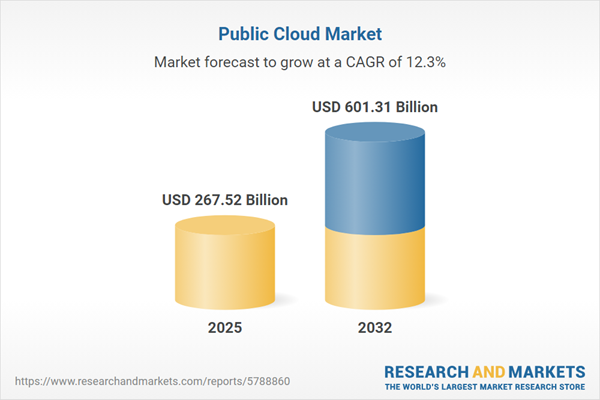Speak directly to the analyst to clarify any post sales queries you may have.
The public cloud market is rapidly transforming how enterprises operate, driving digital innovation and strategic value across industries. Senior leaders are navigating complex technology landscapes, compliance requirements, and evolving business models to realize the advantages of agile, secure cloud solutions.
Market Snapshot: Public Cloud Market Size, Growth, and Trends
The Public Cloud Market grew from USD 238.51 billion in 2024 to USD 267.52 billion in 2025. It is expected to continue expanding at a CAGR of 12.25%, with projections reaching USD 601.31 billion by 2032. This robust trajectory signals increasing cloud adoption as organizations pursue scalable infrastructure and operational flexibility. Market drivers include the upsurge in advanced analytics, AI integration, and regulatory developments impacting investment strategies in both established and emerging regions.
Scope & Segmentation
This report delivers in-depth analysis, forecasts, and trends across critical dimensions:
- Service Type: IaaS, PaaS, SaaS
- Enterprise Size: Large Enterprises, SMEs
- Industry Vertical: BFSI (Banking, Capital Markets, Insurance), Energy and Utilities, Government and Defense, Healthcare, IT & Telecom, Manufacturing, Media and Entertainment, Retail and E-Commerce
- Application: Analytics, Compute, Database, Developer Tools, Networking, Security, Storage
- Subscription Plan: Enterprise Agreements (Custom, One Year, Three Years), Pay As You Go, Reserved Instances, Spot Instances
- Region: Americas (North America, Latin America), Europe, Middle East & Africa (Europe, Middle East, Africa), Asia-Pacific (China, India, Japan, Australia, South Korea, Indonesia, Thailand, Malaysia, Singapore, Taiwan)
- Selected Companies: Amazon Web Services, Microsoft Corporation, Alphabet Inc., Alibaba Group, Tencent Holdings, Oracle Corporation, IBM, Salesforce, Huawei, Baidu
Key Takeaways for Senior Decision-Makers
- Cloud adoption is moving from experimentation to central strategy, with modular architectures enabling agility and rapid feature deployment.
- Large enterprises favor hybrid and multi-cloud approaches for legacy integration, while smaller organizations benefit from turnkey solutions that reduce operational complexity.
- Vertical sectors such as finance and healthcare place strong emphasis on data compliance, while manufacturing and retail prioritize analytics and scalable storage to optimize operations.
- Increasing collaboration between providers and industry ecosystems results in specialized offerings catering to unique sector challenges.
- Flexible consumption and subscription models allow organizations to tailor cost structures and procurement to business needs, reflecting a broad spectrum of risk and optimization preferences.
- Regional cloud strategies must align closely with local regulations, compliance mandates, and digital infrastructure maturity, especially in EMEA and Asia-Pacific regions.
Tariff Impact: Navigating the Effects of US Trade Policy
The implementation of United States tariffs on imported cloud infrastructure hardware in 2025 is impacting provider cost structures and end-user pricing. Providers are diversifying supply chains and renegotiating agreements with regional manufacturers to mitigate increased costs. Some organizations are shifting to local data center partners or reevaluating hardware procurement strategies to reduce exposure. Competitive pressures are leading certain providers to absorb costs in specific segments, making flexible contract terms and robust supply chain management essential for maintaining business resilience amid tariff-driven uncertainties.
Methodology & Data Sources
This analysis is based on a hybrid research framework blending primary executive interviews with secondary data from industry reports, regulatory filings, and vendor disclosures. Quantitative assessments validate adoption rates and usage patterns, supplemented by detailed thematic analysis across leading industry verticals and sub-regions. Strict protocols ensure data integrity and accuracy throughout the research process.
Why This Report Matters
- Enables executive teams to form robust cloud adoption strategies that align with industry-specific challenges and regulatory requirements.
- Delivers actionable insights on optimizing procurement, risk management, and competitive positioning in a changing technology landscape.
- Equips organizations to benchmark cloud deployment practices and identify key levers for driving digital transformation at scale.
Conclusion
The public cloud market is at a turning point, shaped by innovation, regulation, and the imperative for operational agility. Informed strategies and responsive governance will empower organizations to capitalize on emerging opportunities and sustain growth in a dynamic digital landscape.
Additional Product Information:
- Purchase of this report includes 1 year online access with quarterly updates.
- This report can be updated on request. Please contact our Customer Experience team using the Ask a Question widget on our website.
Table of Contents
3. Executive Summary
4. Market Overview
7. Cumulative Impact of Artificial Intelligence 2025
Companies Mentioned
The companies profiled in this Public Cloud market report include:- Amazon Web Services, Inc.
- Microsoft Corporation
- Alphabet Inc.
- Alibaba Group Holding Limited
- Tencent Holdings Limited
- Oracle Corporation
- International Business Machines Corporation
- Salesforce, Inc.
- Huawei Investment & Holding Co., Ltd.
- Baidu, Inc.
Table Information
| Report Attribute | Details |
|---|---|
| No. of Pages | 194 |
| Published | November 2025 |
| Forecast Period | 2025 - 2032 |
| Estimated Market Value ( USD | $ 267.52 Billion |
| Forecasted Market Value ( USD | $ 601.31 Billion |
| Compound Annual Growth Rate | 12.2% |
| Regions Covered | Global |
| No. of Companies Mentioned | 11 |









